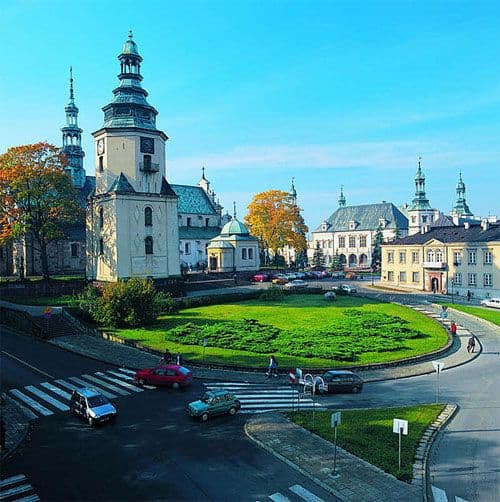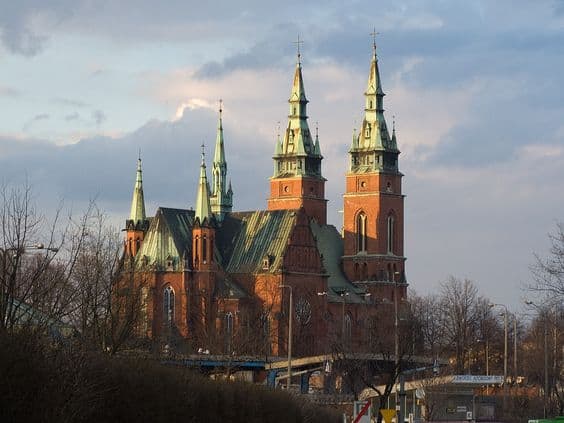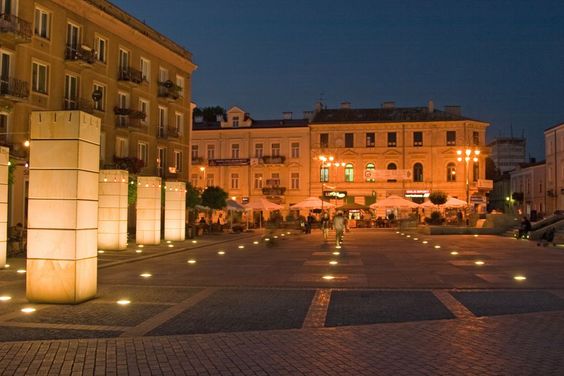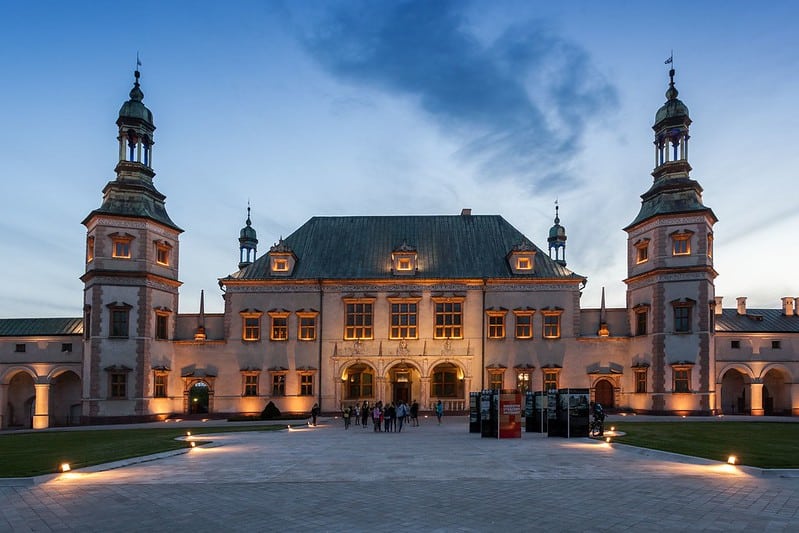Kielce is a southern Polish city with 192,468 residents. It is the capital city of the Witokrzyskie Voivodeship. It was previously the capital of the Kielce Voivodeship. If you’re planning a trip to Kielce, there are many things to see and do.
Kadzielnia Park and Nature Reserve
The Kadzielnia Park and Nature Reservation is one of the best places to visit in Kielce. It is a landmark park featuring geological formations, an underground cave path, monuments, and an amphitheater. You can take a hike around the park or just relax on the grass.
You can also visit the Geoeducation Centre, which opened in 2011. This educational center exhibits Devonian fossils, and offers 5D movies about the region. The Park also features the former Huta Jozef factory, which operated from 1817 to 1866, but was burned down during the January Uprising in 1863-64.
The Kadzielnia Park and Nature Reservation also contains an interesting archaeological site. It features the largest concentration of caves in the Swietokrzyskie Mountains. There are several museums within the park, and you can learn about the history and geology of the area.
Museum of Toys and Play
The Museum of Toys and Play is located in an old covered market and is a must-see for kids of all ages. It has interactive exhibits tracing the history of games and toys. The museum is free to enter and is open all year round.
The Museum of Toys and Play was established in 1979 and moved to its current location in 2006. It features five permanent exhibitions. The most notable exhibition is Toy City, which contains some of the oldest toys and games. You can see dollhouses, teddy bears, and toy soldiers among other objects. The museum also has a play area for children, as well as a courtyard to play in during the summer.
In addition to the permanent exhibits, the museum also offers temporary exhibitions. You can see dolls from the 18th century and historical toys from different countries. The Museum also features a German wax doll from the end of the 18th century.
Muzeum Narodowe w Kielcach
Muzeum Narodowe w Kilcach has been in operation for over 100 years and offers an incredibly diverse array of exhibitions and experiences. You’ll find drogocenny eksponats and wizerunki osobistos from the XVII-XVIII centuries, as well as krajobrazow-rodzajowego obrazow by W. Malecki, as well as krajobrazow and folk art.
Muzeum Dialogu Kultur is a space for cultural dialogue without dominance of one culture or another. The museum presents etnic roznorodnosc and narodowa roznorodnosc. The Muzeum aims to give you a deeper understanding of the richness and diversity of human culture, as well as the human spirit.
Muzeum Narodowe w Kolicach houses valuable exhibits in the fields of natural science, painting, and folk art. The museum also houses a fascinating collection of natural history, archaeology, and handicraft.

Kielce Cathedral
If you’re traveling to the southern part of Poland, you’ll want to check out Kielce. This city has a population of 192,468 people and serves as the capital of the witokrzyskie Voivodeship. The city used to be known as the capital of Kielce Voivodeship, but it has been renamed to witokrzyskie Voivodeship since 1999.
If you’re a history buff, head to the city’s medieval Cathedral and the nearby City Hall. The cathedral is situated on the Castle Hill and is home to a wooded church from the 12th century. A famous event took place here in 1943, as Home Army fighters were executed on the square in front of the cathedral. Sculptures from Krakow are carved into the hill’s steep slopes, and the cathedral has an impressive Rococo high altar.
The city’s cathedral was remodeled in 1171 and contains a treasury of treasures. You can also visit the Bishop’s Palace, a seventeenth century building with a gallery of paintings. In addition to the cathedral, you can also check out the city’s museums and romantic towers.

Karczowka Monastery
The Karczowka Monastery is a fascinating example of early Polish monastic architecture. It is located in the city of Kielce. There are several attractions in Kielce and its surroundings. The city has a number of museums, including the National Museum of Art in the Bishop’s Palace, which features valuable paintings from the XVII and XVIII centuries. The museum also contains many objects from the region’s past, including furniture, Gobelins, marble fireplaces, and portals. Similarly, the Stefan Zeromski Museum features objects related to the writer Stefan Zeromski. You can also visit the Laszczyk Manor House, which has ethnographic expositions.
Located on a hill 319 meters above sea level, the Karczowka Monastery is one of Kielce’s most memorable landmarks. Standing over the city’s dense tree cover, it is an impressive building. The church was constructed by the bishop Szyszkowski in 1624, and was later enlarged by the monastery in 1629 and 1631. An erection board dated 1626 commemorates the construction of the church, which is still displayed in the church porch today.
Ompio
The prison’s history dates back to the second half of the nineteenth century. After the establishment of the Kingdom of Poland in 1816, the prison was located in the former stables of the Bishops of Krakow. In the 70s, all of the buildings were upgraded, including the southern wing. The prison remained in operation until the end of the twentieth century.
Geonatura Kielce
Geonatura Kielce Poland is an educational, turystyczny, and promotional theme park situated on the terrain of Kielce. The park is an ideal place to take children, but it also has many other attractions for the whole family. Here you can learn about the history of Kielce, its geology, and its wildlife.
In Kielce, you can visit the Geopark Kielce, an enchanting landscape reserve that is home to hundreds of animals, birds, and plants. You can also walk the green and blue city trails, which start from the Artists’ Square. This nature reserve was listed as an immovable monument in 2006, and the Geoeducation Centre was opened in 2011. The museum has several exhibits of Devonian fossils, and you can visit the Huta Jozef factory, which was in operation from 1817 to 1866. Unfortunately, this factory was destroyed during the January Uprising of 1863-64. You can also visit Ulica Mala, where the historical buildings of the Huta Jozef factory were once located.
The center also offers geoedukacjne zajecia for schoolchildren, which are designed to help children understand the wonders of the earth’s natural landscape. The museum uses innovative teaching tools and methods to help children understand the science behind geologic phenomena. While visiting Geonatura Kielce, you will learn about the history of the region and how the region was formed.

Jaskinie Na Kadzielni
Kielce, Poland is a small southern Polish city with 192,468 inhabitants. It is the capital of the witokrzyskie voivodeship. Before that, it was a city of the Kielce Voivodeship. Today, the city has a thriving art scene and many things to do.
The city has several historical buildings that are worth a visit. The Cathedral Basilica is one of the best preserved buildings of the Vasa period in Poland. It is also home to the Sanctuary of Our Lady of Grace, the patroness of the city. You can also check out the National Museum. There are rotating exhibitions and historical collections in this museum, which is worth a visit.
The City Trail leads you through 32 historical buildings, reserves, and museums. You can also visit the Palace of the Krakow Bishops, which has more than one hundred life-sized models of the city’s most important buildings and attractions. While it’s not very large, it provides a nice overview of the city’s history. The city is also home to several parks and museums.

